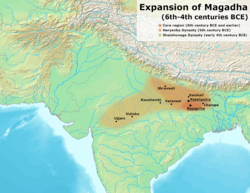Shaishunaga dynasty
Shishunaga dynasty | |||||||||
|---|---|---|---|---|---|---|---|---|---|
| 413 BCE–345 BCE | |||||||||
 Extent of the kingdom | |||||||||
| Capital | Rajgir, Vaishali, later Pataliputra,Patna | ||||||||
| Common languages | Sanskrit Magadhi Prakrit Other Prakrits | ||||||||
| Religion | Hinduism (Brahmanism) Buddhism Jainism[1] | ||||||||
| Government | Monarchy | ||||||||
• 413–395 BCE | Shishunaga | ||||||||
• 367–345 BCE | Mahanandin | ||||||||
| History | |||||||||
• Established | 413 BCE | ||||||||
• Disestablished | 345 BCE | ||||||||
| |||||||||
| History of South Asia |
|---|
 |

The Shishunaga dynasty is believed to have been the second ruling dynasty of Magadha, an empire of ancient India. According to the Puranas, this dynasty was the second ruling dynasty of Magadha, succeeding the legendary dynasty founded by Brihadratha.[2]
Shishunaga, the founder of the dynasty, was initially an amatya or "minister" of the last Haryanka dynasty ruler Nāgadāsaka and ascended to the throne after a popular rebellion in c. 413 BCE.[3] The capital of this dynasty initially was Rajgir; but later shifted to Pataliputra, near the present day Patna, during the reign of Kakavarna. According to tradition, Kakavarna was succeeded by his ten sons.[4] This dynasty was succeeded by the Nanda Empire in c. 345 BCE.[5]
Shishunaga
Shishunaga founded his dynasty in 413 BCE with its capital in Rajgir and later Pataliputra (both in what is now Bihar). Buddhist sources indicate that he had a secondary capital at Vaishali,[6] formerly the capital of Vajji, until it was conquered by Magadha. The Shishunaga dynasty ruled one of the largest empires in the Indian subcontinent.
Kakavarna Kalashoka
According to the Puranas, Shishunaga was succeeded by his son Kakavarna and according to the Sinhala chronicles by his son Kalashoka. On the basis of the evidence of the Ashokavadana, Hermann Jacobi, Wilhelm Geiger and Ramakrishna Gopal Bhandarkar concluded that both are the same. During Shishunaga's reign, he was the governor of Varanasi. The two most significant events of his reign are the Second Buddhist council at Vaishali in 383 BC and the final transfer of the capital to Pataliputra.[7] According to the Harshacharita, he was killed by a dagger thrust into his throat in the vicinity of his capital.[8] According to Buddhist tradition, he had nine or ten sons, who were ousted by Ugrasena Nanda.[9]
Later rulers
According to tradition,[which?] ten sons of Kalashoka ruled simultaneously. The Mahabodhivamsa states their names as Bhadrasena, Korandavarna, Mangura, Sarvanjaha, Jalika, Ubhaka, Sanjaya, Koravya, Nandivardhana and Panchamaka. Only one of them is mentioned in the Puranic lists, Nandivardhana.[4] Nandivardhana or Mahanandin was probably the last ruler of this dynasty; his empire was inherited by his illegitimate son Mahapadma Nanda.[citation needed]
The Puranas list Nandivardhana as the ninth Shishunaga king and his son Mahanandin as the tenth and the last Shishunaga king. Mahanandin was killed by his illegitimate son from a Shudra wife named Mahapadma.[10]
Shishunaga dynasty rulers

- Shishunaga (413-395 BCE) - was a former amatya (official) under the Haryankas.
- Kakavarna Kalashoka (395 BC-?)
- (?-367BCE) Kalashoka had ten sons who ruled the kingdom together for twenty-two years, the name of ten sons are : Bhadrasena, Korandavarna, Mangura, Sarvanjaha, Jalika, Ubhaka, Sanjaya, Koravya, Panchamaka, Nandivardhana
- Mahanandin (367-345 BCE), son of Nandivardhana.
Decline
According to Puranas, Shishunagas were followed by Nanda Empire, which was established by Mahanandin's illegitimate son Mahapadma Nanda.
Notes
- ^ Upinder Singh 2016, p. 273.
- ^ Raychaudhuri 1972, p. 103.
- ^ Raychaudhuri 1972, pp. 193, 201.
- ^ a b Raychaudhuri 1972, p. 196.
- ^ Raychaudhuri 1972, p. 201.
- ^ Singh 2008, p. 272.
- ^ Raychaudhuri 1972, pp. 195–6.
- ^ Mahajan 2007, p. 251.
- ^ Sastri 1988, p. 14.
- ^ Mookerji 1988, p. 10.
References
- Mookerji, Radha Kumud (1988) [first published in 1966], Chandragupta Maurya and his times (4th ed.), Motilal Banarsidass, ISBN 81-208-0433-3
- Singh, Upinder (2008), A History of Ancient and Early Medieval India: From the Stone Age to the 12th Century, India: Pearson Education
- Raychaudhuri, H.C. (1972), Political History of Ancient India, Calcutta: University of Calcutta
- Sastri, K. A. Nilakanta, ed. (1988) [1967], Age of the Nandas and Mauryas (Second ed.), Delhi: Motilal Banarsidass, ISBN 81-208-0465-1
{{citation}}: Unknown parameter|editorlink=ignored (|editor-link=suggested) (help) - Mahajan, V.D. (2007) [1960], Ancient India, New Delhi: S. Chand, ISBN 81-219-0887-6
